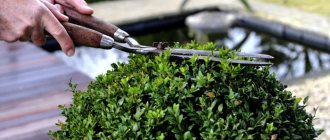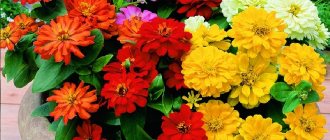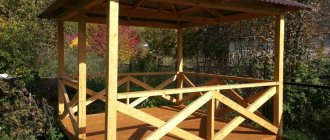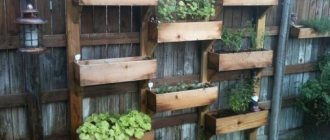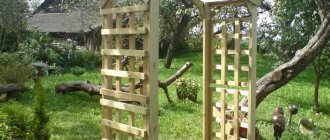The art of ornamental, curly cutting of plants has been known since the times of Ancient Egypt and Ancient Rome. In Russia, it developed during the time of Peter I, when the construction of palaces modeled on Versailles with regular parks around them began. Topiary haircut, in addition to favorably emphasizing the front part of the site, is also necessary when creating private areas for privacy - offices, bosquets, currently fashionable labyrinths, etc.
What to cut
To create topiary objects, as a rule, small-leaved plants are used: the larger the leaves and the sparser the crown, the more space the object or composition takes up. Accordingly, a curtain made of small-leaved linden with a crown trimmed in the shape of a cube, or berso made of small-leaved elm, are appropriate in parks, and in a small garden, plants such as cotoneaster, honeysuckle, Thunberg barberries, cinquefoil, common hawthorn, spirea, and golden currant are used , gray rose, etc.
Berso
There is a classification of plants suitable for topiary haircuts:
- for tapeworms with a molded crown (deciduous and coniferous);
- with a shaped crown (high, medium, low);
- for trimmed walls (scenes);
- for hedges (thorny and non-thorny, of various heights, deciduous and evergreen).
The listing of these plants will take more than one page, so in the framework of this article we will only note that boxwood, which is so popular in Europe, winters relatively stably in our country south of the Kaluga and Tula regions, therefore, the figures cut from it must be kept in containers and put away in the house for the winter, and creating borders or hedges from boxwood is very risky.
By the way, topiary forms in containers displayed at the entrance to the house or in the yard on stone paving will create a feeling of Mediterranean style on your site.
For Russia, as solitary topiary plantings, it is best to use coniferous plants that are consistently decorative all year round - western thuja or junipers (for example, Juniperus virginanum 'Skurosket'); for sculptural pruning, you can take the yew berry that winters here.
Dictionaries define the concept of “topiary” as the art of artistic pruning and giving decorative shapes to the crowns of trees and shrubs.
How did topiary appear?
This type of art was appreciated back in the Roman Empire. The creation of the first topiary is attributed to Caesar's servant. But one way or another, topiary haircut quickly spread throughout Rome: craftsmen with the Latin name “topiaris” actively created unusual landscapes, combining large geometric shapes and animal figures carved from bushes. In medieval literature one can often see pictures of well-trimmed greenery and images of hedges of plants surrounding a garden or gazebo.
The Renaissance was accompanied by the flourishing of landscape art and gardening. The sophisticated design sought to replicate the patterns of tapestries, prints and carpets in the garden. With the help of topiary, long quaint alleys were created, as well as intricate labyrinths and hedges of uneven heights surrounding flower beds and ornamental vegetable gardens. It is an interesting fact that in the Garden of Versailles and in the English Hampton Court, examples of such landscape design are still maintained in their original form.
In the era of classicism, topiary went out of fashion and completely fell into disrepair by the middle of the 18th century. Instead of a curly haircut, society prefers the English park style. But even at this time, you can often find topiary plants on the plots of ordinary poor people who independently tried to decorate their garden or vegetable garden in such a difficult way.
Fashion trends
Modern fashion trends in topiary haircuts offer several directions:
- solitaire figures of animals or hearts, made of yew, thuja and, naturally, boxwood;
- bonsai trimmings;
- haircuts in the form of umbrellas (from field maple or, for example, Canadian serviceberry);
- different shades of color spots (for example, yellow-leaved and red-leaved vesicle or deren - yellow and white variegated forms, as if penetrating each other);
- various figures created using frames, lawns, vines and even annuals (the time for producing the finished composition in this case is significantly reduced);
- trellis forms of various trees (wall, arched);
- trimmed hedges with rhythmic alternation of different colors (arborvitae with green and golden needles, yellow-leaved and purple barberries, etc.
Plants (usually on a trunk, but bush forms can also be used) with various graftings are becoming increasingly common. For example, the weeping form of a tree topped with a clipped “ball”, or foliage of different shades on one plant. You can buy ready-made arches from trees, tie specially curved and trimmed tops together and get not only an arch, but also a living gazebo.
Products by topic
- Choose …
View
Topiary figures
29000 ₽ – 213000 ₽
- Add to cart
View
Topiary figure “Butterfly”
58000 ₽
- Add to cart
View
Topiary figure “Bicycle”
29000 ₽
- Choose …
View
Topiary figure “Cyclist”
58000 ₽ – 173000 ₽
- Add to cart
View
Topiary figure “Camel”
184000 ₽
- Add to cart
View
Topiary figure “Guitar”
58000 ₽
- Add to cart
View
Topiary figure “Horse”
150000 ₽
- Add to cart
View
Topiary figure “Crocodile”
40000 ₽
- Add to cart
View
Topiary figure “Swan”
33000 ₽
- Add to cart
View
Topiary figure "Teddy Bear"
92000 ₽
- Choose …
View
Topiary figure “Bear”
69000 ₽ – 104000 ₽
- Add to cart
View
Topiary figure “Spiral-tree”
32000 ₽
Site selection and care
Trees or shrubs intended for topiary cutting must be planted in a well-lit place to avoid uneven foliage and internal rotting. The soil should be drained, fertile, but not oversaturated with nitrogen.
watered and fertilized according to their purpose (it is incorrect to use fertilizers intended for ornamental shrubs for conifers). Particular care must be taken to monitor the condition of the soil in containers.
trimming should be carried out regularly (but not before winter - so that the plant calmly prepares for hibernation and does not waste energy on additional growth) using garden shears or hedge trimmers (we are talking mainly about trimmed hedges, when a large number of branches are cut and the direction shoot growth is no longer so important), and pruning is done using pruning shears. To compact the crown of the plant, a cut is made above the bud “looking” inward; each branch is cut separately (trellises, tapeworms, bonsai). The wounds are treated in a special way for the fastest healing of the cut.
Pruning should be done in spring. It is advisable to start cutting plants at the age of five (when the root system is already well formed) and not to cut more than one third of the green mass. When cutting, you can use ready-made templates to accurately maintain the originally created shape. The ideal shape for a clipped hedge is wide at the bottom and tapering at the top, so that the lower branches receive enough light.
Standard plants, due to their high windage, must be tied up or strengthened with guy wires until they are completely rooted.
In winter , trees and shrubs are tied with twine or covered with special frames to avoid breaking branches under the adhering snow. In the first year of planting, you can also shade conifers from sunburn.
This art requires significant costs both for the creation of figures, ornaments or hedges, and for the constant maintenance of garden design objects in the desired form. In any case, it is better to entrust the care of pruned plants to specialists, and then the original compositions conceived by the designer will decorate your garden for many years.
Suitable plants for topiary art
To form living figures, cypress, boxwood, yew, privet and beech are most often used. It is these plants that have the main advantages over others. They quickly recover after pruning, grow a dense crown, have slow growth, and a long life span. In some cases, forsythia, hornbeam, oak, holly and cherry laurel can be trimmed. These plants have small leaves and thin branches that are easy to trim. Shapes can be created from Norway spruce, cotoneaster, western thuja and hawthorn, among other plants. The main condition for successful pruning is proper care of these plants before and after it.
Haircut or trimming
It is necessary to distinguish between the concepts of “haircut” and “trimming”. When pruning, they deal with each branch individually, using pruning shears. There are rules regarding how to make a cut, which buds to stimulate, how to treat wounds, etc.
And pruning is also called blind pruning, when it doesn’t matter where exactly on the branches the cuts are made. The whole plant is simply trimmed to the established dimensions. In this case, you can no longer use pruning shears, because you need to cut a lot of branches.
The haircut is carried out using garden shears, petrol or electric hedge trimmers. Pruning is usually done in the spring, and shearing is done several times a season.
___________________________________________________
Garden bonsai - trees in miniature
Thai style bonsai formed from bougainvilleas
When you hear the word “bonsai”, the image of a tree in a pot, for example a pine or an oak, appears in your mind, which is an absolute copy of a real forest giant, only tiny in size.
How to make topiary with your own hands
DIY topiary
To create topiary you will need to clearly know what you want to achieve, as well as have certain gardening skills. Important helpers are enormous patience, time and regular work. Complex, sophisticated forms of topiary can only be built by professionals who specialize in this type of decorative haircut. But many simple forms are beautifully made by enthusiastic amateurs who have stocked up with the necessary tools and relevant literature. You can easily buy special frames for growing topiary in the store. It is recommended to start learning this difficult art with the simplest forms: cone, cube, hemisphere.
Only strong and healthy plants are suitable for topiary. An alternative to this pruning would be climbing ivy planted against a wire frame. Such ivy usually wraps around the frame in one season and looks no worse than real topiary made by an experienced amateur.
